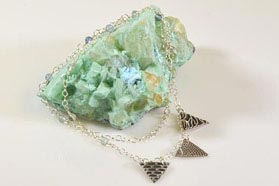Rings & Things Jewelry Blog
Metal Etching 101
Etching is a method of using chemicals to cut a design or pattern into a metal surface. Etching your own designs into metal is easier than it may sound, and it can be a fun and rewarding way to make your own jewelry! Learn the basics of how to choose your metals, choose your etchants, create or transfer your images with resists, and complete the etching process. Discover how to make a float boat for suspending your designs in etchant — plus find basic etching safety precautions, design consider
…
Oct 26th 2021
Crimping 101
Using crimp beads to finish a necklace or bracelet: 1. String a crimp bead onto the beading cord or wire cable, then string the clasp. 2. Bend the cable back through the crimp bead. 3. Tighten the loop (but not too tight!). Use crimping pliers to crimp the bead into a small round crimp, or use flat-nose pliers to simply flatten the crimp. 4. Trim the excess cord/cable. 5. Use crimping pliers to close a crimp cover over the crimp bead. For all crimping, apply pressure similar to a firm handshake,
…
Oct 26th 2021
Wire Jewelry 101
Jewelry making wire gives you endless choices in creativity! Still, it's easier to get started once you know a few basic tips and terms that will help you determine what type of wire to use for your jewelry projects. Learn about different shapes, gauges, and materials of craft wire.Find full tutorials, jewelry projects, and supplies too.Wire GaugesThe gauge of a piece of wire is a measurement of its width (diameter). Gauge is often abbreviated as "ga", thus 20 gauge = 20ga. There are two main ga
…
Oct 18th 2021
How to Make Loops on Head & Eye Pins
Basic Loops:The loop size will depend on how much wire you leave past the end of your beads, and around which part of your pliers you bend the loop. A good loop size is usually about 1/3 of the way from the tip of your pliers, with about 8mm of wire.Use round needle-nose pliers.If using an eye pin, decide which way you want the loop to go - the same direction as the premade loop on the other end, or 90º off. Keep this direction in mind as you bend the rest of the wire.Cut off any excess wire (we
…
Sep 15th 2021
Metal Clay 101
Learn the basics of what metal clay is, and how to make your own custom beads, jewelry findings, and small art objects with this exciting craft medium. Find details about various brands including firing schedules and usage tips for Art Clay Silver (ACS silver clay), Precious Metal Clay (PMC silver clay), WHITE COPPRclay, original COPPRclay brand copper clay, and BRONZclay brand bronze clay. You can also shop our line of metal clays (while they last!) and firing supplies.What is Metal Clay?M
…
Mar 2nd 2015
Riveting 101
Learn the basics of riveting, including how to distinguish various types of rivets and how to set different rivets. Riveting is a classic, durable and popular way to create cold connections in jewelry designs (a "cold connection" is the joining together of metal components without using solder). Each type of rivet used to make jewelry requires different tools and techniques. Discover these methods below. Once you're ready to create your own custom riveted jewelry, check out our full line of rive
…
Jan 1st 2015
Jewelry Safety: Lead Content Classifications
At Rings & Things, we work hard with manufacturers and testing agencies to ensure that our products meet the requirements of California's lead-in-adult-jewelry law, the most stringent law in the U.S.A. regarding lead content in adult jewelry. Products in our online store are labeled according to the classification chart below. Information on this page covers the basics you need to know to comply with California law. Even if you don't live in California, you might need to follow these guide
…
Feb 14th 2012






